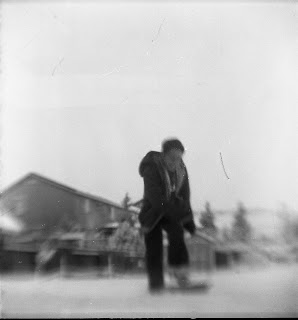Color me impressed.

I like to fly airplanes, albeit I've done it precisely once in my life. It was last summer, and I did it on a
mid-life crisis bucket list self-dare, totally inspired by the works of
Tim Ferriss. My lesson worked out well and, as a result, I'm likely to get back up in the sky soon. Or at least when the money's right. Flying, like photography, ain't cheap, so I've really got to call my shots when I do go up.

The main reason I decided to learn to fly an airplane is because flying was always my number one fear. Like 200bpm heart rate, sweat pouring off of me, sheer panic-inducing, omygod I'm gonna die right now afraid. I decided if I was going to slay the dragon, I'd better cut off his head while I was at it. Now, I've rekindled my interest in things that fly and that extends to my photos.
Above are some planes that routinely catch my eye at the Stead Airport where I've taken lessons.
They are, from top:
1. Beechcraft A45
2. Mig 15 UTI
3. 1947 North American Navion
4. Wide shot of Stead airport
5. Unidentified jet. I need to ask around to find out what this is, as there is no visible tail number. Reminds me a little of
Chuck Yeagar's X1.
I took these shots on a
Kodak Funsaver Panoramic disposable camera. What follows is a quick how-to if you want to resurrect an old disposable cam from the dead.
Reusing disposable cameras
I've long heard about the magical properties lurking within the nooks and crannies of one-time-use disposable plastic cameras, the sort of which used to dot wedding tables and parties the world over before the inevitable rise of iPhones. In particular, Nevada's
Deon Reynolds is doing some mind-blowing work with these little hunks of plastic. Stop what you're doing right now and check out his
black and white work. Completely inspiring stuff.
When headed out to the Reno-Stead Airport, home to the annual Reno Air Races, I thought I'd bring along one of the el-cheapo disposables to test out. Mind you, this concept beats a hasty retreat from the realm of reasonable cost-cutting and solidly enters "urban foraging" territory. These cameras, once shot, are ostensibly actual garbage. To rescue one from its certain landfill fate is to be on par with the city dumpster diver. Nonetheless, I found one and brought it home to call my own.
.JPG) |
$9 eBay acquisition. These are hard to come by. Remove the paper coating
making sure not to break off the lens hood. Remember, it's all plastic. |
Now it was time to see first-hand what sort of alchemy these throw-away cameras were capable of. Starting with a Kodak Fun Saver Panoramic one-time-use plastic cam, I ripped off the paper backing and started tearing into the body proper. It took a flathead screwdriver and no small bit of nerve to crack the plastic body open. Once inside, I found a simple camera setup, but with a twist. Instead of the film starting in its original canister and moving over to a take-up spool to be rewound later, you have to unload all of the film into the take-up spool prior to shooting.
.JPG) |
Gently pry open the body with your hands and a flathead screw driver.
Remove film canister. |
There's only one way to accomplish this, and it's in a very dark place. Seek out the darkest depths of Mordor and start digging, because you're never going to do this without complete, soul-terrifying darkness. Light + film = no bueno.
Once in the dark room, go at it. You've got four parts to hook up.
1. The takeup spool
2. The film cartridge
3. The body proper (not to be confused with the Body Electric - my love for Whitman is fodder for another blog)
4. The back
.JPG) |
Feed film leader from right to left into takeup spool. Do the rest in the dark,
loading the takeup spool fully, then snapping the back on. It can be tricky.
You may want to practice with a throwaway roll of film to get the feel for it.
You'll also need to reset the film counter to 15. Do this as gently as possible. |
Of all the steps, getting the back snapped back on in the dark takes the most patience.
Practice it without film in the light and really nail it down before trying it with real film. Once you get it snapped in, you're almost set.
Wind a few frames, reset the counter on top to 15 (A flathead also is handy for this task) and shoot away. You've got yourself a regular trashcam that'll give you results like the ones I shot above.











.JPG)
.JPG)
.JPG)



